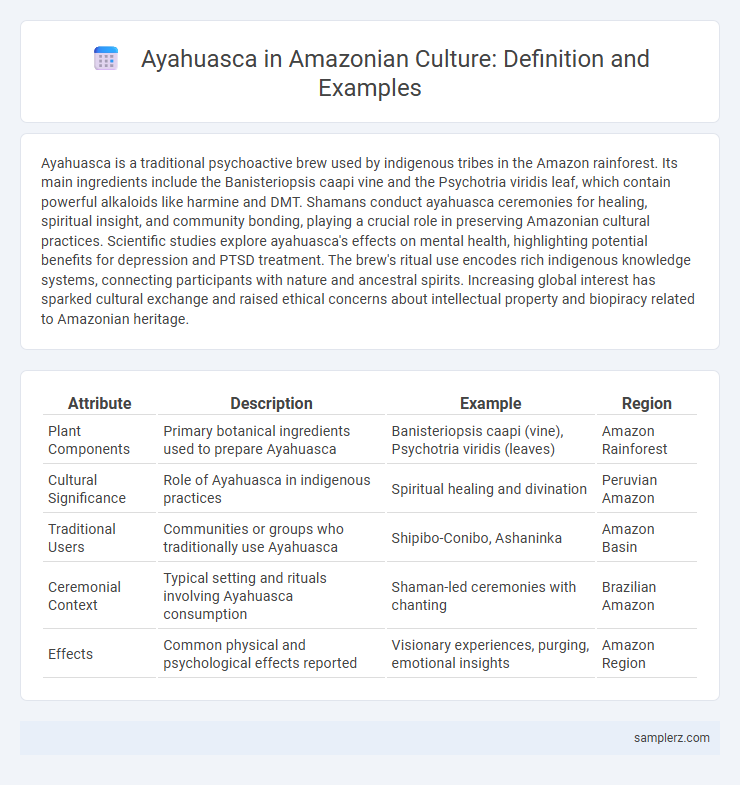Ayahuasca is a traditional psychoactive brew used by indigenous tribes in the Amazon rainforest. Its main ingredients include the Banisteriopsis caapi vine and the Psychotria viridis leaf, which contain powerful alkaloids like harmine and DMT. Shamans conduct ayahuasca ceremonies for healing, spiritual insight, and community bonding, playing a crucial role in preserving Amazonian cultural practices. Scientific studies explore ayahuasca's effects on mental health, highlighting potential benefits for depression and PTSD treatment. The brew's ritual use encodes rich indigenous knowledge systems, connecting participants with nature and ancestral spirits. Increasing global interest has sparked cultural exchange and raised ethical concerns about intellectual property and biopiracy related to Amazonian heritage.
Table of Comparison
| Attribute | Description | Example | Region |
|---|---|---|---|
| Plant Components | Primary botanical ingredients used to prepare Ayahuasca | Banisteriopsis caapi (vine), Psychotria viridis (leaves) | Amazon Rainforest |
| Cultural Significance | Role of Ayahuasca in indigenous practices | Spiritual healing and divination | Peruvian Amazon |
| Traditional Users | Communities or groups who traditionally use Ayahuasca | Shipibo-Conibo, Ashaninka | Amazon Basin |
| Ceremonial Context | Typical setting and rituals involving Ayahuasca consumption | Shaman-led ceremonies with chanting | Brazilian Amazon |
| Effects | Common physical and psychological effects reported | Visionary experiences, purging, emotional insights | Amazon Region |
Introduction to Ayahuasca in Amazonian Culture
Ayahuasca, a traditional Amazonian brew made from the Banisteriopsis caapi vine and Psychotria viridis leaves, plays a central role in indigenous spiritual practices. This potent psychedelic is used in ceremonial contexts to facilitate healing, divination, and communication with the spirit world. The ritualistic consumption of ayahuasca reflects deep cultural beliefs about nature, ancestry, and the interconnectedness of all life in Amazonian societies.
Historical Significance of Ayahuasca Ceremonies
Ayahuasca ceremonies in the Amazon hold profound historical significance as they have been practiced by indigenous tribes for thousands of years as a spiritual and healing tradition. These ceremonies facilitate deep connection with nature, ancestral knowledge, and communal identity, serving as a foundational element in cultural transmission. The ritual use of ayahuasca continues to influence contemporary understandings of indigenous wisdom and cosmology in Amazonian societies.
Indigenous Tribes and Their Ayahuasca Traditions
Indigenous tribes in the Amazon, such as the Shipibo-Conibo and the Ashaninka, have preserved ancient ayahuasca traditions for centuries, using the brew in spiritual ceremonies to facilitate healing and communication with the spirit world. These rituals involve shamans who guide participants through visionary experiences aimed at personal insight, physical healing, and community bonding. The cultural significance of ayahuasca among these tribes reflects a deep understanding of the rainforest ecosystem and an enduring ancestral knowledge system.
Ritual Practices Surrounding Ayahuasca Use
Ayahuasca rituals in the Amazon are deeply rooted in indigenous spiritual practices, involving ceremonial chanting, specific dietary restrictions, and guided sessions by experienced shamans. These ceremonies facilitate healing, self-discovery, and communication with the spirit world, often lasting through the night in a communal setting. The intricate use of ayahuasca vine and chacruna leaves is central to these rituals, reflecting a profound cultural reverence for nature and ancestral knowledge.
Spiritual Beliefs Connected to Ayahuasca
Ayahuasca, a sacred brew used by indigenous Amazonian tribes, holds profound spiritual significance in shamanic rituals and healing ceremonies. Its consumption is believed to facilitate communication with the spirit world, enabling seekers to gain insight, clarity, and emotional healing through guided visions. These spiritual beliefs emphasize interconnectedness with nature, ancestors, and cosmic forces, forming the core of Amazonian cultural identity and traditional knowledge.
Role of Shamans in Ayahuasca Ceremonies
Shamans play a central role in Ayahuasca ceremonies in the Amazon, acting as spiritual guides who facilitate the safe and meaningful use of the sacred brew. They use traditional rituals, chants, and deep knowledge of medicinal plants to navigate participants through intense visionary experiences and healing processes. The shaman's expertise ensures the harmonious connection between the physical and spiritual realms, preserving ancient cultural traditions and promoting mental and emotional well-being.
Ayahuasca and Its Healing Purposes
Ayahuasca, a traditional Amazonian brew made from the Banisteriopsis caapi vine and Psychotria viridis leaves, is revered for its profound healing properties, particularly in mental and spiritual health. Indigenous communities use ayahuasca ceremonies to facilitate deep psychological healing, emotional cleansing, and insight into personal traumas, supported by the brew's active compounds, DMT and harmaline. Scientific studies increasingly validate ayahuasca's potential in treating conditions like depression, PTSD, and addiction through its unique neuropsychological effects.
Traditional Preparation of Ayahuasca Brew
The traditional preparation of ayahuasca involves harvesting the Banisteriopsis caapi vine and the Psychotria viridis leaves, which are carefully combined in precise ratios based on indigenous knowledge. The vine is cleaned, pounded, and boiled slowly over many hours to extract the active alkaloids, while the leaves are added later to infuse the brew with dimethyltryptamine (DMT). This meticulous process is deeply rooted in Amazonian cultures, reflecting a sacred connection to nature and spiritual healing practices.
Modern Adaptations of Ayahuasca in the Amazon
Modern adaptations of ayahuasca in the Amazon involve integrating traditional shamanic rituals with contemporary therapeutic practices, attracting global tourists seeking spiritual healing. Scientific studies have explored ayahuasca's potential in treating depression, PTSD, and addiction, influencing its use beyond indigenous contexts. Eco-tourism initiatives emphasize sustainable harvesting and cultural respect, ensuring the preservation of Amazonian biodiversity and spiritual heritage.
Cultural Preservation and Challenges Facing Ayahuasca Traditions
Ayahuasca ceremonies in the Amazon are integral to the cultural identity of indigenous communities, serving as a sacred practice for healing and spiritual connection. Efforts to preserve these traditions face challenges such as commercialization, loss of biodiversity, and external exploitation, which threaten the authenticity and sustainability of the rituals. Protecting ayahuasca heritage requires collaboration between indigenous leaders, environmental advocates, and policymakers to ensure respect for ancestral knowledge and ecological balance.

example of ayahuasca in Amazon Infographic
 samplerz.com
samplerz.com